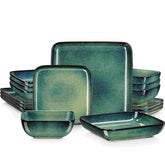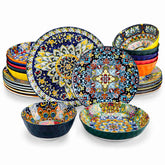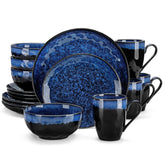The Psychology of Color in Dinnerware: How Your Plate Choice Impacts Appetite
Your dinnerware works as a psychological instrument to steer your eating habits through subtle effects on portion size and food preferences while influencing your feelings of fullness. Food presentation reveals plate color as an understated determinant that affects appetite while determining satisfaction levels.
People have extensively researched color psychology throughout the development of marketing practices along with branding areas and design principles. Plate color during meals influences both your perception of food portions and the way your food appears appetizing. Knowledge about how color psychology impacts your dinnerware could result in fundamental alterations to your mealtime behavior no matter your goals of portion control or feeding fussy children or improving your dining ambiance at home.
The Science on Your Table: How Plate Color Messes With Your Mind (and Stomach)
Research has extensively documented the Delboeuf illusion which demonstrates that food appears different in size based on the color contrast between plate and food. When food stands out against a dark blue plate, people tend to serve themselves larger portions because the portions look smaller. When you serve pasta on a white plate its portion will appear bigger thus potentially reducing your food intake.
Another aspect is color-emotion association. The energetic properties of yellow and red colors work well for advertising fast food yet they might prove counterproductive during mindful eating moments. The calming effect of blue and green and grey color tones can potentially reduce appetite.
Research shows people eat more when their environment including their plates creates a welcoming feeling. Restaurants use earthy and elegant whites in their design because these colors make food appear more attractive and delectable.
What Specific Dinnerware Colors Mean for Your Appetite
The impact of particular plate colors affects how you perceive food while also influencing your mood and appetite levels.
White Plates
White dinnerware provides a timeless appearance that lets food stand out. The combination of white plates with pale-colored foods such as pasta or rice leads to overeating because of reduced color contrast. White dinnerware serves as an effective tool to showcase both vegetables and sauces because of its strong color contrast abilities.
Red Plates
Red is a double-edged sword. Research shows red plates can stimulate appetite through their association with fast food branding, yet they might also function as a weak signal to stop eating. The use of red dinnerware could be practical for people who are working on portion management.
Blue Plates
The scarcity of blue in natural foods makes this color effective at reducing appetite. Blue plates serve as a potential tool to help people eat less at meals. Dieting individuals sometimes use blue tableware because these plates encourage them to take diminished food portions.
Black Plates
Black plates stand out for keen contrast which heightens portion visibility and delivers impressive appearance. The plates serve to make portions more visible or they create an illusion of higher food value. Black has a tendency to project heavy or formal characteristics which could make it an unsuitable option for casual eating occasions.
Yellow Plates
Yellow dinnerware creates a positive and bright atmosphere that lifts spirits. The color yellow on plates enhances appetite while encouraging social interaction which makes it suitable for both social gatherings and breakfast meals. The plates could lead to excessive eating if you do not pay attention to your food consumption.
Green Plates
Green plates connect with human perceptions of both natural elements and health. This color choice enhances attention to body signals during meals and showcases food quality. Great for salads, fruits, and plant-based meals.
Grey Plates
Grey plates maintain a contemporary look yet they create unappealing food presentation unless the dishes receive proper styling. The plate base works to reduce appetite but remains suitable for presenting colorful food arrangements.
Multicolored or Patterned Plates
The brain struggles to recognize food portions when you use plates with excessive visual distractions through patterns or complex designs. The visual appeal of these plates should be limited to basic designs because they affect mindful eating.
Other Plate Tricks Influencing What (and How Much) You Eat
Color represents one aspect of the complete visual experience. Your dinnerware's dimensions together with its surface texture and design shape can produce unexpected effects on your eating experience.
Plate Size
The use of large plates results in increased portion sizes regardless of your actual hunger level. Visual scaling distorts food perception because large plates make food appear smaller which leads you to add more.
Plate Shape
Circular plates remain the standard but square or rectangular plates create better spatial boundaries that help you measure portions more accurately.
Rim Width
The wide decorative edges on plates create an optical illusion that makes the center area seem smaller thus reducing your portion size without your awareness.
Bowl vs. Plate
The use of bowls instead of plates for pasta and rice helps portion control more effectively when the bowls are deep and small rather than wide and shallow.
Contrast with Table and Food
Your food becomes more visible when your plate is in high contrast with it, which might result in better satisfaction. When food matches the color of the plate, people receive less visual feedback about their consumption which leads to increased eating.
Putting Psychology to Work: Choosing Your Colored Dinnerware Sets
You have learned about color and design effects on appetite and eating behaviors so now you can use this knowledge to select dinnerware for personal use, family meals and entertaining guests. A suitable dinnerware option brings an enhanced dining atmosphere and assists with your wellness needs.
For Portion Control and Mindful Eating
People who want to eat less or practice mindful eating should choose blue or red plates with smaller diameters. Research shows that blue and red colors work as natural appetite suppressants which also extend meal duration. Your food becomes easier to track and monitor when the plate contrasts with food and creates strong visual differences between dark plates and light-colored food. Large white plates with light-colored food should be avoided since they create an optical illusion of reduced portion sizes which might result in overeating by accident.
For Encouraging Appetites (e.g., Kids, Elderly)
The colors yellow, orange and soft pink work best to boost appetite in children and elderly people and picky eaters. The colors create welcoming environments that boost food perception regarding warmth and flavor. The selection of plates designed with boundary elements and frames enables meals to maintain focus while drawing attention to their central point. Using small plates helps people perceive their meals more approachable and not as huge obstacles to eating.
For Healthy Eating Goals
Using plates with a green color serves as an effective signal of culinary choices that benefit wellness. The use of green plates along with bowls of matching colors makes nutritious items such as vegetables and grains appear more appetizing to our brains.
For Entertaining Guests
Maintain either white or black dinnerware when serving guests at your home. These gray and beige color options allow your food to stand out while they keep the display non-disruptive. The table decorations you choose will bring color and personality which transforms your theme while allowing the plates to stay the same.
For Everyday Balance
Variety is key. A modular collection features tones from mild to vibrant which enables you to arrange your table according to taste and food requirements. The search must yield minimalist designs with multiple functional uses to maximize storage efficiency.
Elegant plate shapes along with soft color palette from brands like vancasso and MALACASA align beautifully with mental food objectives. Prioritize buying dinnerware that promotes your eating preferences rather than designing for looks or searching for the lowest prices.
Seven shades make up the color wheel yet the choice of your dinnerware color creates significant psychological effects. Every dish color at your dinner table triggers brain signals that steer your eating behavior and determine portion amounts along with satiation levels. Knowledge about dinnerware color effects on behavior and appetite allows you to create both pleasurable dining experiences and thoughtfully mindful mealtimes.
Color works as a discreet companion that supports you throughout serving portions and hosting elegant dining meals alongside helping relatives reach their eating goals. During your next table setup consider the messages that your plate conveys to others.













